Vienna is not huge. It is a substantial city, and it is a capital city, with about 2 million inhabitants, and about 2.6 million in its metropolitan area. It has a long history, combining remnants of Imperial Majesty with established and privileged middle class culture, the memory of terrible prejudices, and a strong and sometimes right-wing tradition of populism and social democracy. It is a cosmopolitan center, a mixed place for a very long time, attracting and blending Germans, Slavs, Italians and Hungarians. There used to be many Jews, now very few, although our number will grow with new Jewish refugees from the Ukraine and the several thousand passports that have/are being given to descendants of Austria’s Nazi victims. There are Turks, who have now been here for some time, and a sprinkling of everyone from everywhere else.
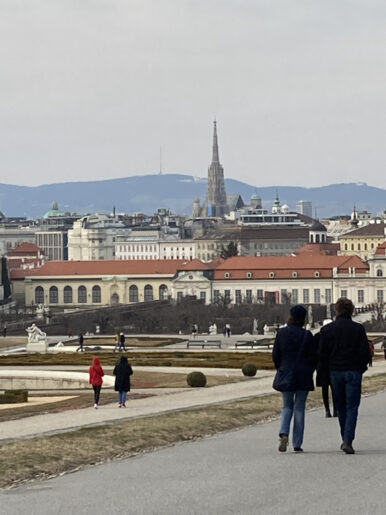
Have I seen and understood all this in a mere six weeks? Certainly not, at least not too deeply. But I can see elements of it, and they are a unique and entrancing blend that make this an interesting and urbane place, although calmer and smaller than the New York I have been used to.
At the center of Vienna is its Innere Stadt (Inner City), and the old Hofburg or Imperial Palace of the Hapsburgs, who ruled this place and many others for hundreds of years. I haven’t yet been to the Hofburg; I confess that Imperial Majesty does not particularly interest me. Grandeur is often more impressive than it is exquisite.
I am a new Austrian citizen, one of those descendants of Nazi victims, now living in a short-term rental apartment in the Meidling District (Bezirk 12), a collection of former villages melded into an urban working class neighborhood at the end of the 19th century. The buildings are low-rise, five or six stories generally, with flat stucco/cement facades. They are colorless, and the streets don’t have trees. I am told that much of this area was bombed at the end of World War II and then rebuilt.
Nevertheless, I am enjoying the Meidling. It is clean and the services are superb, with at least three supermarkets within a five-minute walk and a very good outdoor market, the Meidlinger Markt, with permanent structures on a nearby square. Every basic service imaginable is within a few blocks of me, many on a large pedestrian shopping street, the Meidlinger Hauptstrassse, where strangely enough (to the New Yorker) none of the stores are vacant or closed and all look busy with pedestrian shoppers. Most of the stores are chains, and few of them beautiful, but here and there are places to get special things. This especially at the Markt which has a superb small restaurant and a very good wine and cheese store. I have met the owners of these places, and they are interesting people whose English is far better than my German.
The supermarkets are reasonably priced and well-stocked. One has an in-market bakery and a cheese section; another has inexpensive jams and alcohol. I bought a sim card and phone number in one, with an ID card, and the monthly subscription is $11-12, for calls within Austria.
The bread here is very good, dense, grainy, tasty. I find it in the supermarkets, on the market square and at a nearby bakery. Eating it in the morning is like having a full meal. And at the bakery, there is a plain, elongated pastry, with a sweet poppyseed filling, which reminds me of the humentaschen we had as children at Purim. It has a different shape and name, and the crust and the taste are better, but it is very much the same.
I was never a boy who had an interest in trains, yet I am wowed by the transportation system, the metro lines and the streetcars—I have hardly yet tried the buses. Some of the tracks are below ground or partially so, and some are elevated, so the scenery and the light are constantly changing. What I see from the trains is not a consistent street pattern, but a series of places that have been tied together.
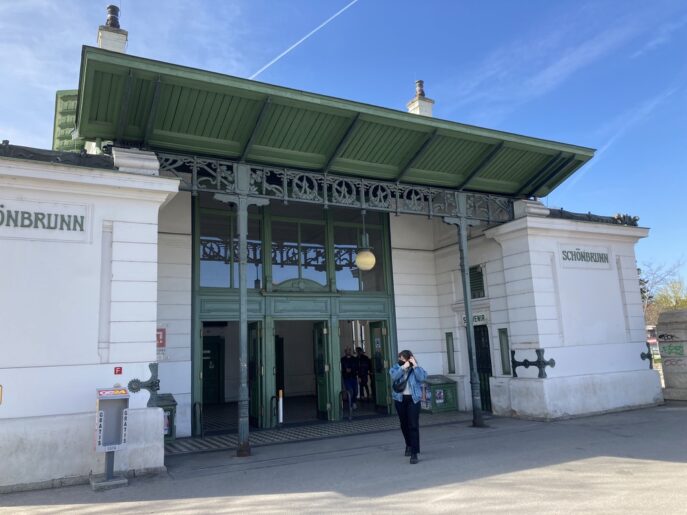
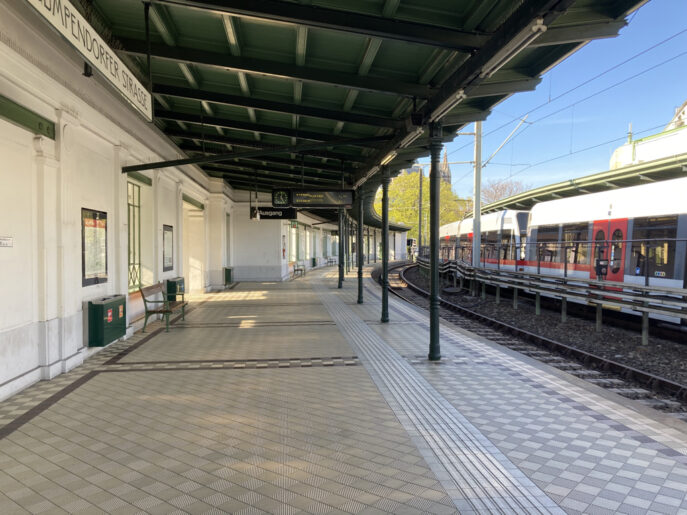
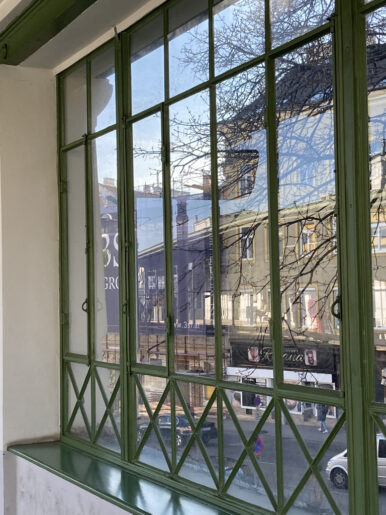
Google maps points me easily to the best routes to take, and I am nearly anywhere I want to go in a half hour or less. The trains are quiet and sometimes busy, but not overcrowded, the stations are well maintained, with working elevators, and they are clean. What a pleasant surprise! Some, presumably those pictured here, are more than a century old, designed by the famous Viennese architect, Otto Wagner. Many, particularly the larger ones, are more recent, as the system was expanded beginning in the 1970’s. Riding is peaceful. There are a few crazy people and a few asking for money or imposing their music. But in far fewer numbers than in New York. Are there fewer of them, or are they taken care of differently? I don’t know yet.
Generally, the city is very clean, both the streets and the metro stations. There are public bathrooms, sometimes in the stations or in parks, markets, and squares. They are manned (or wo-manned), sometimes renovated and typically spotless. The cost is 50 cents, and well worth it. What a pleasure to avoid the stress of looking for a bathroom. (In New York, I walk into cafés, restaurants or hotels—sometimes I have to ask. Fortunately, I can. . . a freedom perhaps not available to everyone. Here anybody just pays.) And then there are the public swimming pools, to be discussed. . . !
Some of the most extraordinary elements of Vienna developed from its 19th century bourgeois culture, they are for and by those who can pay something for them. Luxury had been extremely limited, before being brought forward to a much broader public in the 19th century. The three most evident here are the coffee house, the museum and the concert hall. But a detailed discussion of these, again, will follow.
Regarding the streetscape, many neighborhoods are also dominated by buildings from the 19th century. When I read about the development of Vienna—more specifically when I read the historian Carl Schorske, I understand Vienna’s pre-modern Inner City to have been surrounded by its 19th century Ringstrasse. But my walks are leading me to the broader observation that 19th century buildings not only surround, but also penetrate the inner core. There is a thick band of buildings inside much of the Ring, and even at the center of the Innere Stadt, that is 19th century buildings as well.
Beyond the Ring, there is yet another thick band of 19th century construction and beyond that, even more 19th century neighborhoods. Vienna’s grandeur largely reflects this 19th century peak in its urban development, or what Schorske describes as the peak of its Liberal order. This grandeur post-dates the city’s prime as an Imperial Capital, since Austria was relatively stronger in the 18th than it was in the late 19th century. (Faced with Napoleon, the Hapsburgs dissolved the Holy Roman Empire in 1806 and lost a significant war to Prussia in 1866.)
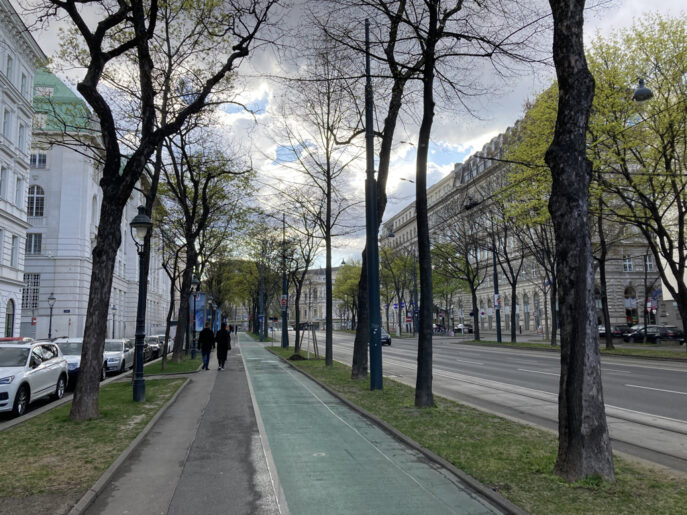
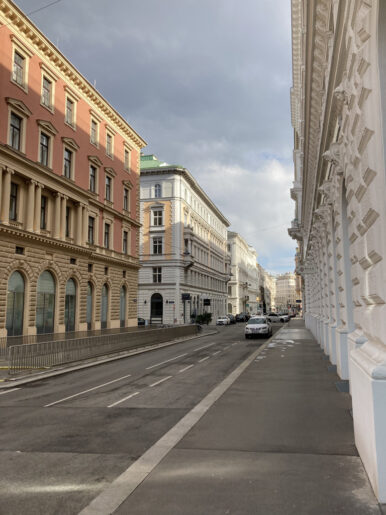
The architectural character of Vienna, in the eclectic historical style of the 19th century, is nevertheless austere. The facades are detailed, but somber. The facades dominate the street, generally not the trees and not what inhabits them. The buildings are primarily residential, and retail space often seems unimportant, a characteristic again described by Schorske. In fact active retail is often nonexistent except in the old center, on certain commercial streets, and on the most central segment of the Ringstrasse.
Thus there is stature but an often austere emptiness to Vienna’s 19th century streetscape that is completely unlike the more lively dense streets of the Innere Stadt. And as Schorske mentions, the 19th century buildings are typically an adjunct to the movement of the street, which he contrasts with the oppositional view of buildings on a square. In Paris, the 19th century boulevard often has a focal point, the Arc de Triomphe, La Madeleine, the Place de la Concorde, and it often has active outdoor cafés and retail space. The Innere Stadt has these; but not so much the 19th century districts.

Very interesting, Larry !
I look forward to reading, and learning, more. Struck by the austerity, per your comments and pictures, compared to the elegance and bustle of Parisian boulevards.
Perhaps the city’s liveliness and spirit is best felt in its music and concert halls ?
Keen to find out.
Thank you Deborah!
Larry good evening,
Thank you for this first introduction to Vienna. I have just passed it to Fred who Zoé es the week-end there! Interesting to see the city as a new citizen, I was there as a tourist and loved the Hofsburg and Schonbrunn + the opera and the sécession building! History is really meaningful for Austrian people!! The Habsburg dynasty was a key to understand what Europe is today…
Enjoy your new life there!
🥰
Larry good evening,
Thank you for this first introduction to Vienna. I have just passed it to Fred who spends the week-end there! Interesting to see the city as a new citizen, I was there as a tourist and loved the Hofsburg and Schonbrunn + the opera and the sécession building! History is really meaningful for Austrian people!! The Habsburg dynasty is a key to understand what Europe is today…
Enjoy your new life there!
🥰